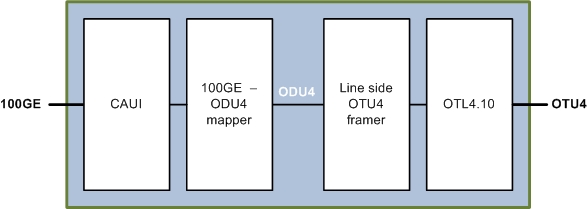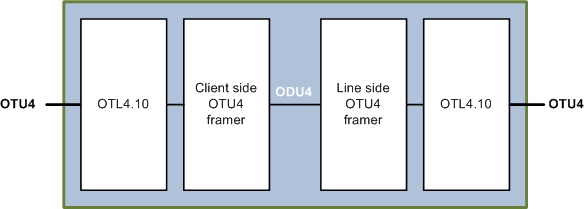AppliedMicro’s TPACK unit has unveiled the first of its 100 Gigabit Optical Transport Network (OTN) designs. Two devices were announced in November 2010 - the TPOT414 and TPOT424 - that perform 100 Gigabit mapping and framing functions, while in December a 100 Gigabit OTN muxponder (multiplexer-transponder) was announced that combines several of its designs.
 “The real market demand is for simple systems - the transponder and interfaces to the routers"
“The real market demand is for simple systems - the transponder and interfaces to the routers"
Lars Pedersen, AppliedMicro
Why is this significant?
The OTN standard, defined by the telecom standards body of the International Telecommunication Union (ITU-T), has existed for a decade but has emerged recently as a key networking technology.
“SONET/SDH is now legacy while packet optical is next-generation work,” says Sterling Perrin, senior analyst at Heavy Reading. “OTN has emerged as an interim step away from SONET/SDH that is able to handle packets.”
With the advent of 100 Gigabit-per-second (Gbps) optical transmission, OTN has been upgraded to handle 100Gbps signals and multiplex existing 10Gbps and 40Gbps OTN within the 100 Gigabit framing format. AppliedMicro claims to be first-to-market with merchant 100Gbps OTN hardware.
AppliedMicro’s 100Gbps OTN designs are implemented using field-programmable gate arrays (FPGAs) and will become available to system vendors this quarter. Using FPGAs allows vendors to start their hardware designs early, adding AppliedMicro’s FPGA software as the OTN design is completed.
What has been done?
The TPOT414 and TPOT424 designs, implemented on a line card, perform mapping - taking a 100 Gigabit client-side signal and turning into a 100Gbps line-side signal for transmission - and regeneration of a 100Gbps signal.
The 100Gbps OTN muxponder uses framing and mapping but adds multiplexing between 10, 40 Gbps and 100Gbps streams. One application is a router taking IP traffic at different rates and framing them before transmission over a 100Gbps dense wavelength division multiplexing (DWDM) network.
The 100Gbps muxponder comprises AppliedMicro’s PQ60 framer/mapper chip and multiplexing FPGA products, referred to by AppliedMicro as soft silicon. “It [soft silicon] is a combination of an FPGA and the programming image delivered as one unified component,” says Lars Pedersen, TPACK’s CTO. “There is still some uncertainty as to the specification and what is needed.”
The benefits of a soft silicon approach compared to an application-specific standard product (ASSP) include the ability to reprogram the design to accommodate standards’ changes, and allowing system vendors to add new elements as they customise their designs.
AppliedMicro also provides an application programming interface (API) which simplifies control and maintenance when several of its designs are combined to implement a more complex function. “From a software perspective it looks like one combined function,” says Pedersen. The 100Gbps muxponder, for example, is controlled via the API. The API also allows software reuse were AppliedMicro to offer the functions as an ASSP chip.
The TPOT OTN architecture
The two functions – the TPOT414 and TPOT424 – are implemented on a common FPGA design.
 The TPOT414: Source: AppliedMicro
The TPOT414: Source: AppliedMicro
The TPOT414 has a 100 Gigabit Ethernet (GbE) CAUI interface (10 x 11.2Gbps) and performs physical coding sub-layer (PCS) monitoring per lane before mapping the signal into OTU4, prior to long-haul transmission. The two signals - the 100GbE and the 100Gbps line side - have separate clocks and the role of the mapper is to place the 100GbE stream into the OTN format.
The TPOT414 could be used to interface two optical modules on a line card: a CFP module that takes in a 100GbE client signal and an MSA-168 long-haul transponder whose electrical input is the OTN OTU4 signal.
 The TPOT424 Source: AppliedMicro
The TPOT424 Source: AppliedMicro
The second design, the TPOT424, takes in an OTU4 signal made up of a payload and overhead components. The overhead part that includes a forward error correction (FEC) is terminated - errors corrected and signal measurements made – before the payload is put into a new OTU4 frame and a fresh overhead including a new FEC scheme is applied.
Both the TPOT414 and TPOT424 use standard FEC from the ITU-T G.709 standard. Separate devices in the optical module are needed if more powerful FECs are used. AppliedMicro says it will support more powerful FECs in future 100Gbps OTN devices.
“These [the TPOT414 and TPOT424] are the bulk of the emerging market and are the most needed components to start with,” says Pedersen.
The 100G OTN muxponder also supports the multiplexing function, including support for 10GbE and 40GbE, OC-192 and OC-768 SONET/SDH, and 8Gbps and 10Gbps Fibre Channel signals
What next?
Pedersen says there is now significant demand for its 100Gbps OTN designs as vendors prepare to launch systems supporting 100Gbps interfaces in 2011 and 2012. These include packet optical transport platforms and 100Gbps IP router line cards.
“The real market demand is for simple systems - the transponder and interfaces to the routers,” says Pedersen. “But at the same time there are many vendors working on packet optical transport platforms.”
The company does not rule out developing ASSP designs that support100Gbps OTN.